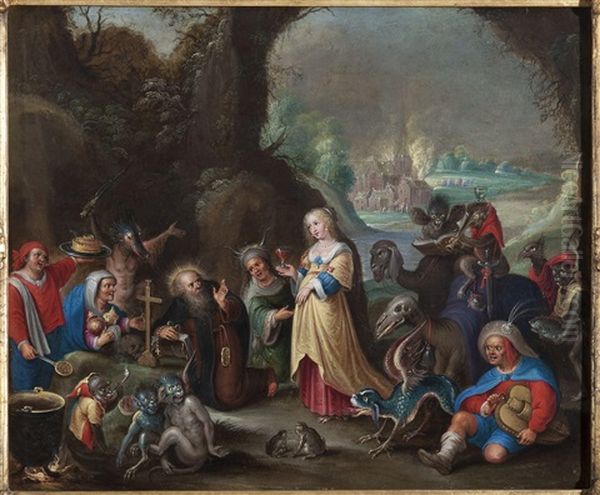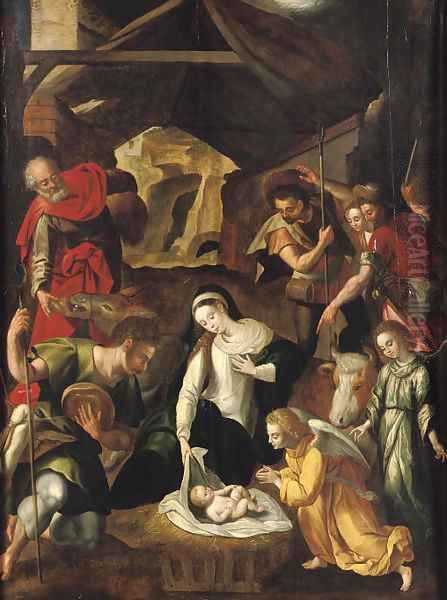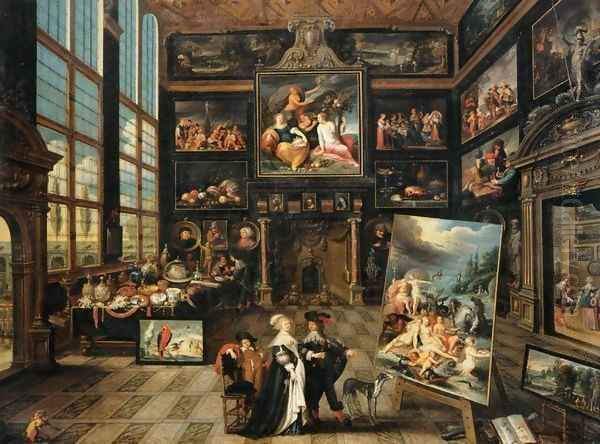The 17th century in Flanders, particularly in Antwerp, was a period of extraordinary artistic effervescence. Amidst the towering figures of Peter Paul Rubens, Anthony van Dyck, and Jacob Jordaens, a host of specialized painters flourished, catering to a discerning clientele eager for diverse subject matters. Among these was Cornelis de Baellieur the Elder (1607-1671), an artist who carved a distinct niche for himself as a master of the "constkamer," or collector's cabinet painting. These intricate works not only showcased his technical skill but also provide invaluable insights into the culture of collecting, the art market, and the social aspirations of the Baroque era.
Early Life and Artistic Formation in Antwerp
Cornelis de Baellieur was born in Antwerp in 1607, into a world where art was deeply interwoven with the city's identity and economy. His father was also a painter, and likely an art dealer, suggesting that Cornelis was immersed in the artistic milieu from a young age. This familial connection to the art world would prove significant throughout his career.
His formal training began under Antonis Lisaert (also known as Anthonis Lijssens), a painter of whom less is widely known today but who was evidently a recognized master capable of imparting the necessary skills. By 1626, at the relatively young age of nineteen, Cornelis de Baellieur was registered as an independent master in the prestigious Antwerp Guild of Saint Luke. Membership in the Guild was crucial for any artist wishing to practice professionally, take on apprentices, or sell their works openly in the city. This early acceptance into the Guild signifies his recognized talent and completion of a rigorous apprenticeship.
The Antwerp Art Scene: A Crucible of Talent
To understand De Baellieur's career, one must appreciate the environment in which he worked. Antwerp, despite political and economic shifts, remained a leading European art center. The legacy of earlier masters like Quentin Matsys and Pieter Bruegel the Elder had laid a strong foundation. In De Baellieur's time, the dominant force was undoubtedly Peter Paul Rubens, whose dynamic Baroque style and large workshop influenced generations. Anthony van Dyck, though spending much of his career abroad, also emerged from this vibrant scene, as did the prolific Jacob Jordaens.

This environment fostered not only grand history paintings and portraits but also a wide array of specialized genres. Still life, landscape, genre scenes, and, pertinently for De Baellieur, the unique category of gallery or cabinet paintings, all found eager patrons. The city was a hub for art dealing, with works being created not just for local consumption but for export across Europe, a trade in which De Baellieur himself would become involved.
Specialization: The "Constkamer" or Gallery Painting
Cornelis de Baellieur is primarily celebrated for his "constkamer" or "pronkkamer" (gallery or show-room) paintings. This genre, which gained immense popularity in Antwerp during the first half of the 17th century, depicted real or idealized collections of art and curiosities. These paintings served multiple purposes: they were status symbols for their owners, celebrations of connoisseurship and learning, and complex allegories of wealth, knowledge, and sometimes vanity.
Artists like Willem van Haecht, Hieronymus Francken II, and Frans Francken the Younger (also known as Frans Francken II) were key figures in developing this genre. De Baellieur followed in their footsteps, often collaborating with other artists and developing his own distinct approach. His gallery scenes are typically characterized by rooms, often grand in scale, with walls densely hung with miniature representations of recognizable paintings. Sculptures, globes, scientific instruments, books, musical instruments, exotic shells, and other "naturalia" and "artificialia" (objects of nature and human creation) would often be artfully arranged, showcasing the breadth of the collector's interests.
Key Characteristics of De Baellieur's Style
De Baellieur's gallery paintings are meticulously detailed. He possessed a refined technique, enabling him to render the varied textures of fabrics, metals, wood, and the miniature paintings-within-paintings with remarkable precision. His figures, often elegant and somewhat elongated, populate these spaces, engaging in conversation, examining artworks, or simply admiring the collection. These figures are not merely staffage; they animate the scene and guide the viewer's eye, embodying the ideal of the cultured art lover.
His compositions are typically well-ordered, often employing a clear perspectival recession to create a sense of depth and space. While the rooms are filled with objects, there is usually a sense of harmony rather than clutter. The lighting in his works tends to be even, illuminating the details clearly, though he could also employ more dramatic chiaroscuro effects characteristic of the Baroque when the subject demanded. His color palette is generally rich and varied, reflecting the diverse objects depicted.

A notable aspect of De Baellieur's work, and of the genre itself, is the depiction of actual, identifiable artworks by other masters. This practice not only added to the prestige of the painted collection but also served as a form of art historical documentation, showing which artists and styles were valued at the time. These miniature copies demonstrated the painter's versatility and skill in emulating different artistic hands.
Notable Works and Their Significance
Several key works exemplify De Baellieur's contribution to the "constkamer" genre. "A Collector's Gallery" (circa 1635-1640 or circa 1640, depending on the specific version, with one notable example housed in the Swiss National Museum, Zurich) is a quintessential example. It depicts a spacious room where elegantly dressed figures admire a vast array of paintings covering the walls from floor to ceiling. Sculptures, a globe, and other precious objects are also present. The painting celebrates the act of collecting and the intellectual pursuits associated with it. The interactions between the figures suggest a learned discourse on art.
Another significant work often attributed to him, or created in collaboration, is "The Studio of Rubens" (circa 1635-1640 or 1645-1650). This painting, sometimes linked with Jan Brueghel the Younger for the still life elements or figures, offers a fascinating glimpse into the idealized workspace of the great master. It is less a literal depiction of Rubens's actual studio and more a tribute, showcasing a collection of (miniature) works associated with Rubens or his circle, alongside classical sculptures and other symbols of artistic learning. Such paintings underscored the elevated status of the artist as an intellectual and a creator.
A work titled "Picture Gallery" further illustrates his specialization. These paintings often featured allegorical figures or themes, such as personifications of the Arts or depictions of famous collectors. The sheer density of artworks within these painted galleries speaks to the flourishing art market and the desire to possess and display a wide range of artistic productions.
Collaborations and Artistic Network
Collaboration was a common practice in 17th-century Antwerp, allowing artists to combine their specialist skills for a richer final product. De Baellieur was no exception and engaged in several important artistic partnerships.
He is known to have worked in the studio of Frans Francken the Younger, a leading figure in the development of the gallery painting genre. The influence of Francken is evident in De Baellieur's choice of subject matter and his meticulous style. It's highly probable that De Baellieur honed his skills in depicting complex interiors and miniature artworks under Francken's guidance.

De Baellieur also collaborated frequently with Hans Jordaens III, another painter active in Antwerp. Together, they produced numerous gallery scenes, with one artist often responsible for the architectural setting and the miniature paintings, and the other for the figures. This division of labor was efficient and played to each artist's strengths.
His association with Jan Brueghel the Younger is particularly noteworthy, especially in relation to works like "The Studio of Rubens." Jan Brueghel the Younger, son of the famous Jan Brueghel the Elder (the "Velvet Brueghel"), specialized in floral still lifes, allegorical scenes, and landscapes, often contributing these elements to works by other painters. The Brueghel family was renowned for its refined detail and jewel-like finishes, qualities that complemented De Baellieur's own meticulous approach.
Beyond these direct collaborations, De Baellieur was part of a wider network of artists. He would have known and interacted with many other painters active in Antwerp, including figures like David Teniers the Younger, who also excelled in genre scenes and occasionally painted gallery interiors, and Gonzales Coques, known as the "little Van Dyck" for his elegant small-scale group portraits often set in opulent interiors.
Beyond the Gallery: Religious and Mythological Themes
While best known for his "constkamer" scenes, Cornelis de Baellieur was a versatile artist who also tackled other subjects, primarily religious and mythological themes. This demonstrated his capacity to work within the more traditional and often more prestigious genres of history painting.
Among his religious works is "The Temptation of Saint Anthony" (circa 1640). This popular Counter-Reformation subject allowed artists to explore themes of faith, temptation, and the grotesque, often filling the canvas with fantastical demons and alluring figures. De Baellieur's interpretation would have showcased his imaginative powers and his ability to handle complex multi-figure compositions.
Other religious subjects he is known to have painted include "The Adoration of the Shepherds" (a version is noted as being in Antwerp, and another was auctioned in Paris in 2022) and various Crucifixion scenes, such as "Croixfixion avec la Madeleine au pied de la Croix" (auctioned in Paris, 2010) and "The Crucifixion - Christ and the Veronese" (auctioned). These works, often smaller in scale and painted on copper or panel, were intended for private devotion and catered to the religious sensibilities of his patrons. A "Virgin and Child with Angel Musicians" also passed through Christie's in Amsterdam.
His handling of these subjects would have drawn upon the established iconographic traditions of Flemish art, but imbued with his characteristic attention to detail and refined execution. These works underscore his broader capabilities as a painter beyond his primary specialization.
De Baellieur as an Art Dealer and Assessor
Cornelis de Baellieur was not only a creator of art but also actively involved in its trade. This dual role was not uncommon for artists in the 17th century. His family background, with his father likely being an art dealer, provided a natural entry into this aspect of the art world.
He had significant connections with prominent art dealers in Antwerp. His nephew, Guillam Forchondt the Elder, ran one of the most important art dealing firms in Antwerp, with extensive international connections, exporting Flemish art across Europe, including to Vienna, Spain, and Portugal. De Baellieur is recorded as having produced paintings specifically for Forchondt's export business. Similarly, his brother-in-law, Matthijs Musson (or Musch), was another influential art dealer and publisher in Antwerp who commissioned works from various artists, including De Baellieur. These familial and professional ties placed De Baellieur at the heart of Antwerp's dynamic art market.
His expertise was also recognized in his capacity as an art assessor. He is documented as having been called upon to evaluate the works of other artists, a testament to his connoisseurship. Notably, he was involved in assessing paintings by the great Anthony van Dyck, indicating the high regard in which his judgment was held by his peers and by the authorities. This activity further highlights his deep immersion in the practical and commercial aspects of the art world.
Later Life, Legacy, and Attribution Challenges
Cornelis de Baellieur remained active in Antwerp throughout his career, continuing to produce his sought-after gallery paintings and other works until his death in 1671. His paintings were popular during his lifetime, valued for their intricate detail, elegant figures, and their celebration of art and learning.
His legacy primarily rests on his contribution to the "constkamer" genre. These paintings are more than just charming depictions of collections; they are historical documents. They offer insights into what was collected, how art was displayed, the social rituals surrounding art appreciation, and the intellectual currents of the time. They reflect the pride of Antwerp as a center of artistic production and connoisseurship.
Like many artists of his era who worked in collaborative environments or whose styles were emulated, De Baellieur's oeuvre presents some attribution challenges. The similarity in style and subject matter among painters specializing in gallery scenes, coupled with the frequent practice of collaboration where different hands contributed to a single work, can make definitive attributions difficult. Scholars continue to study his works, and those of his contemporaries like Frans Francken II, Hieronymus Francken II, and Wilhelm Schubert van Ehrenberg, to delineate individual contributions and understand the complex workshop practices of the time. Some works are securely attributed through signatures or contemporary documentation, while others are assigned based on stylistic analysis. For instance, a "Presentation to the Magi" auctioned at Poisson et Associés shows the continued market interest in works attributed to him.
Conclusion: A Window into the Baroque Art World
Cornelis de Baellieur the Elder may not have achieved the monumental fame of Rubens or Van Dyck, but his contribution to Flemish art is significant and enduring. As a specialist in the "constkamer" painting, he masterfully captured the spirit of collecting and connoisseurship that characterized the Baroque era in Antwerp. His meticulously detailed and elegantly composed works open a window onto the opulent interiors and intellectual pursuits of 17th-century art lovers.
Through his collaborations with artists like Frans Francken the Younger, Hans Jordaens III, and Jan Brueghel the Younger, and his involvement in the art trade via figures like Guillam Forchondt and Matthijs Musson, De Baellieur was deeply embedded in the rich artistic fabric of his time. His paintings, whether depicting bustling art galleries or more intimate religious scenes, reflect a high level of technical skill and a keen understanding of his patrons' desires. Today, his works are prized not only for their aesthetic appeal but also for the invaluable cultural and historical information they convey, securing his place as an important chronicler of the 17th-century art world.